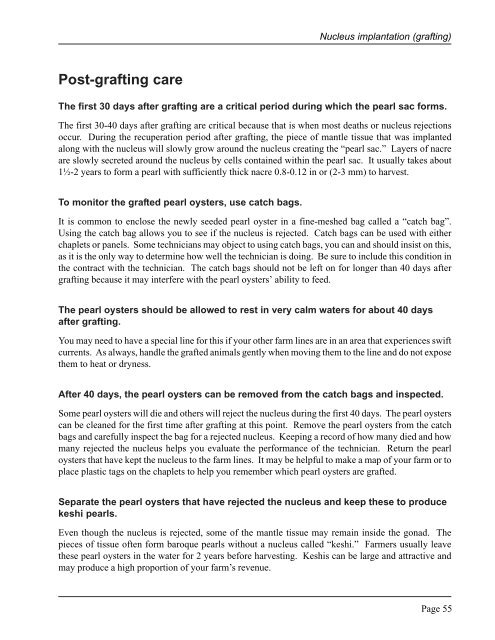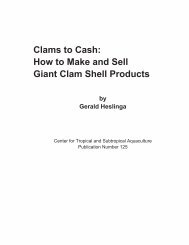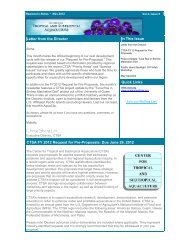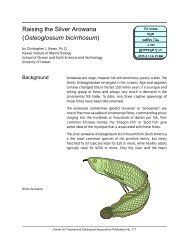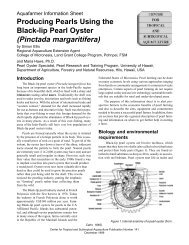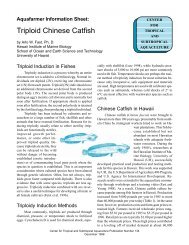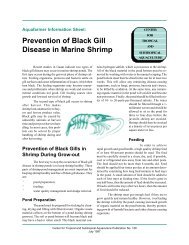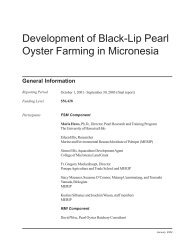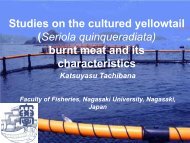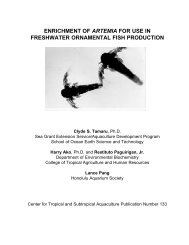The Basic Methods of Pearl Farming: A Layman's Manual - CTSA
The Basic Methods of Pearl Farming: A Layman's Manual - CTSA
The Basic Methods of Pearl Farming: A Layman's Manual - CTSA
You also want an ePaper? Increase the reach of your titles
YUMPU automatically turns print PDFs into web optimized ePapers that Google loves.
Nucleus implantation (grafting)Post-grafting care<strong>The</strong> first 30 days after grafting are a critical period during which the pearl sac forms.<strong>The</strong> first 30-40 days after grafting are critical because that is when most deaths or nucleus rejectionsoccur. During the recuperation period after grafting, the piece <strong>of</strong> mantle tissue that was implantedalong with the nucleus will slowly grow around the nucleus creating the “pearl sac.” Layers <strong>of</strong> nacreare slowly secreted around the nucleus by cells contained within the pearl sac. It usually takes about1½-2 years to form a pearl with sufficiently thick nacre 0.8-0.12 in or (2-3 mm) to harvest.To monitor the grafted pearl oysters, use catch bags.It is common to enclose the newly seeded pearl oyster in a fine-meshed bag called a “catch bag”.Using the catch bag allows you to see if the nucleus is rejected. Catch bags can be used with eitherchaplets or panels. Some technicians may object to using catch bags, you can and should insist on this,as it is the only way to determine how well the technician is doing. Be sure to include this condition inthe contract with the technician. <strong>The</strong> catch bags should not be left on for longer than 40 days aftergrafting because it may interfere with the pearl oysters’ ability to feed.<strong>The</strong> pearl oysters should be allowed to rest in very calm waters for about 40 daysafter grafting.You may need to have a special line for this if your other farm lines are in an area that experiences swiftcurrents. As always, handle the grafted animals gently when moving them to the line and do not exposethem to heat or dryness.After 40 days, the pearl oysters can be removed from the catch bags and inspected.Some pearl oysters will die and others will reject the nucleus during the first 40 days. <strong>The</strong> pearl oysterscan be cleaned for the first time after grafting at this point. Remove the pearl oysters from the catchbags and carefully inspect the bag for a rejected nucleus. Keeping a record <strong>of</strong> how many died and howmany rejected the nucleus helps you evaluate the performance <strong>of</strong> the technician. Return the pearloysters that have kept the nucleus to the farm lines. It may be helpful to make a map <strong>of</strong> your farm or toplace plastic tags on the chaplets to help you remember which pearl oysters are grafted.Separate the pearl oysters that have rejected the nucleus and keep these to producekeshi pearls.Even though the nucleus is rejected, some <strong>of</strong> the mantle tissue may remain inside the gonad. <strong>The</strong>pieces <strong>of</strong> tissue <strong>of</strong>ten form baroque pearls without a nucleus called “keshi.” Farmers usually leavethese pearl oysters in the water for 2 years before harvesting. Keshis can be large and attractive andmay produce a high proportion <strong>of</strong> your farm’s revenue.Page 55


